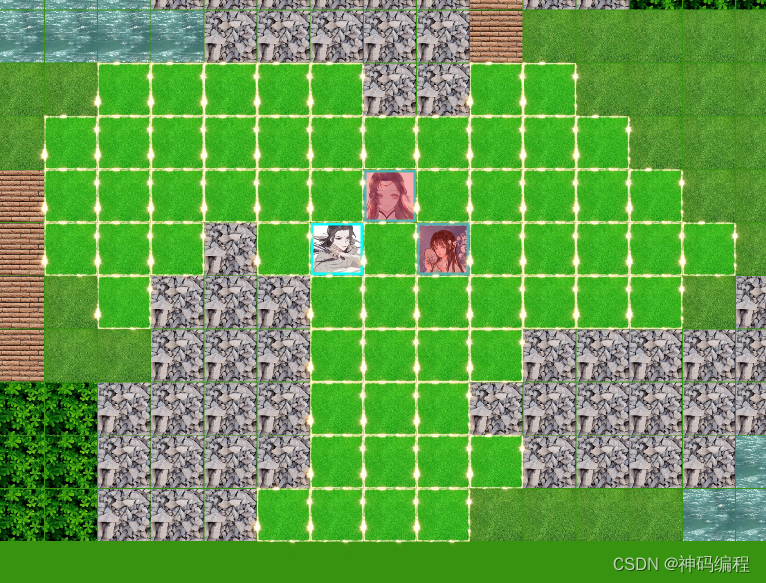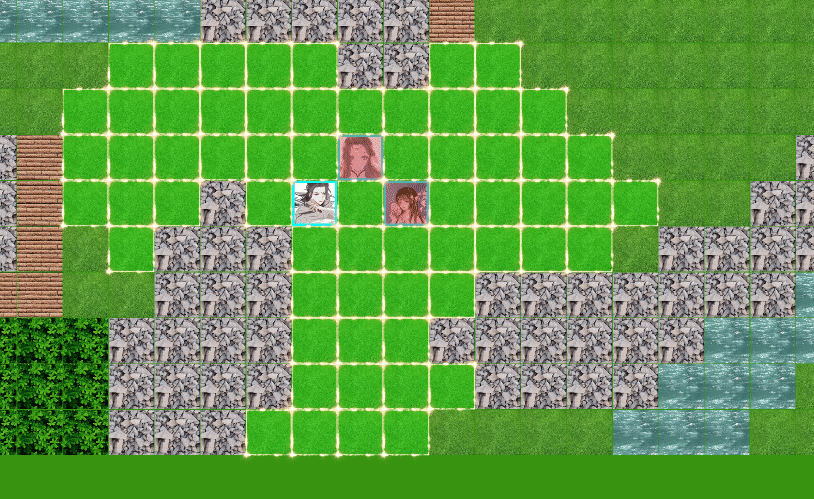更新日期:2024年7月4日。
项目源码:第五章发布(正式开始游戏逻辑的章节)
索引
简介
寻路系统是整个游戏最核心的功能之一,角色的移动和战斗都是基于寻路系统来进行的,毕竟我们的游戏有三分之一的战棋血统。
一、寻路系统
由于HTFrameworkAI模块正好支持如下我们游戏需要的寻路核心功能:
- 1.两点间寻路;
- 2.寻可行走节点。
所以首先就是引入该模块,更多信息请参阅:【Unity】 HTFramework框架(二十七)A*寻路。
二、寻路规则(角色移动)
对于我们角色的移动和攻击而言,移动速度和攻击距离便是其寻路计算时的最大依据。
比如移动速度=10,则角色初始移动能力=10,每移动一格(地块),移动能力-1,当移动能力减至0时,角色无法再继续移动。
同时,不同类型的地块对移动能力还会产生额外的削减:
- 1.地面:-0;
- 2.山体:-1;
- 3.森林:-1;
- 4.湖泊:-1;
- 5.雪地:-2;
- 6.障碍:不可通行;
- 7.敌方占领地块:不可通行。
这也是角色行走到山体上会被减速的功能点的实现方式。
不过,一些特殊加成型要诀能够抵消地块的额外削减,但是,在我们的进程中,特殊加成型要诀尚在构思阶段,所以,具体的实现我们后续一步步来。
三、寻路规则(角色攻击)
角色攻击是同理的,不过角色攻击寻路规则跟地块类型的关系有所不同:
- 1.地面:可以跨越攻击;
- 2.山体:可以跨越攻击;
- 3.森林:可以跨越攻击;
- 4.湖泊:可以跨越攻击;
- 5.雪地:可以跨越攻击;
- 6.障碍:不可跨越攻击;
- 7.敌方占领地块:可以跨越攻击。
由于角色攻击寻路几乎只针对远程攻击(近程攻击只能攻击身边的4格,用不着寻路),所以这里的可以跨越攻击及不可跨越攻击也即是指攻击时是否能够跨越该地块攻击敌人。
同理,一些特殊加成型要诀能够改变如上的规则。
四、角色移动寻路
1.自定义寻路规则
要做到如上这么多自由的想法,自定义寻路规则是必须的,所幸HTFrameworkAI的A*寻路支持自定义寻路规则,那么我们便立即开始吧(继承至AStarRule即可):
/// <summary>
/// 寻路规则(角色移动)
/// </summary>
public class MoveRule : AStarRule
{
/// <summary>
/// 当前的关卡
/// </summary>
public Level CurrentLevel;
/// <summary>
/// 当前寻路的角色
/// </summary>
public Role CurrentRole;
/// <summary>
/// 目标地块
/// </summary>
public Block TargetBlock;
//寻路前,对所有A*节点应用自定义规则
public override void Apply(AStarNode node)
{
//通过节点索引找到其对应的地块
Block block = CurrentLevel.Blocks[node.XIndex, node.YIndex];
//如果地块上存在敌人(阵营不同)
if (block.StayRole != null && block.StayRole.Camp != CurrentRole.Camp)
{
//则该地块不可行走
node.IsCanWalk = false;
return;
}
switch (block.Type)
{
case BlockType.Ground:
// OCost 为该节点的额外估价,寻路计算时将造成【移动能力】的额外削减
// 此处 = 0,则表明无额外削减
node.OCost = 0;
node.IsCanWalk = true;
break;
case BlockType.Moutain:
//山体:将造成【移动能力】额外 -1
node.OCost = 1;
node.IsCanWalk = false;
break;
case BlockType.Forest:
node.OCost = 1;
node.IsCanWalk = true;
break;
case BlockType.Water:
node.OCost = 1;
node.IsCanWalk = false;
break;
case BlockType.Snow:
node.OCost = 2;
node.IsCanWalk = true;
break;
case BlockType.Obstacle:
//障碍:将造成该地块不可行走
node.IsCanWalk = false;
break;
}
}
}
如上的代码应该很好理解了,足以可见,自定义寻路规则是何其的简单。
2.寻角色的所有可行走地块
角色移动前,能够根据角色自身移动速度,周围地块属性等,寻找出所有可以移动的地块以供玩家选择:
private static MoveRule _moveRule;
private static List<Block> _resultBlocks = new List<Block>();
/// <summary>
/// 寻路规则(移动)
/// </summary>
private static MoveRule CurrentMoveRule
{
get
{
if (_moveRule == null)
{
_moveRule = new MoveRule();
}
return _moveRule;
}
}
/// <summary>
/// 寻找角色的可行走地块
/// </summary>
/// <param name="level">关卡</param>
/// <param name="role">角色</param>
public static List<Block> FindWalkableBlocks(Level level, Role role)
{
if (level == null || role == null || role.Speed == 0)
{
_resultBlocks.Clear();
return _resultBlocks;
}
CurrentMoveRule.CurrentLevel = level;
CurrentMoveRule.CurrentRole = role;
//WalkableNodefinding 为 A* 寻路方法,具体参阅 HTFrameworkAI
//参数1:role.StayBlock.Pos 寻路起点
//参数2:role.Speed 移动速度
//参数3:传入自定义寻路规则
List<AStarNode> nodes = level.Map.WalkableNodefinding(role.StayBlock.Pos, role.Speed, CurrentMoveRule);
//寻路结果为A*节点集合,通过节点索引获取对应的地块即可
_resultBlocks.Clear();
for (int i = 0; i < nodes.Count; i++)
{
_resultBlocks.Add(level.Blocks[nodes[i].XIndex, nodes[i].YIndex]);
}
return _resultBlocks;
}
寻找到所有可行走地块后,接下来只需要高亮这些地块即可,同时让玩家可以点击选择(高亮方式就取决于自己了,当然这块逻辑也有涉及,不过在最后的实现UI界面时讲解):

比如这里的角色络英俊,移动速度为7,周围高亮的都是可行走的地块,其他在移动范围内的便是不可行走的地块。
3.寻角色到达指定地块的路径
上一步已经寻找到了所有可移动地块,如果玩家点击了其中的一个,则表明期望角色移动到该地块,所以需要寻角色到达该地块的路径:
/// <summary>
/// 寻找角色到达指定地块的路径
/// </summary>
/// <param name="level">关卡</param>
/// <param name="role">角色</param>
/// <param name="block">目标地块</param>
public static List<Block> FindPathBlocks(Level level, Role role, Block block)
{
if (level == null || role == null || block == null)
{
_resultBlocks.Clear();
return _resultBlocks;
}
CurrentMoveRule.CurrentLevel = level;
CurrentMoveRule.CurrentRole = role;
//Pathfinding 为 A* 寻路方法,具体参阅 HTFrameworkAI
//参数1:role.StayBlock.Pos 寻路起点
//参数2:block.Pos 寻路终点
//参数3:传入自定义寻路规则
List<AStarNode> nodes = level.Map.Pathfinding(role.StayBlock.Pos, block.Pos, CurrentMoveRule);
_resultBlocks.Clear();
for (int i = 0; i < nodes.Count; i++)
{
_resultBlocks.Add(level.Blocks[nodes[i].XIndex, nodes[i].YIndex]);
}
return _resultBlocks;
}

当然,这里的角色移动动画涉及到战斗系统中的内容了,在我们的进程中它还不存在,我们先忽略。
五、角色攻击寻路
1.自定义寻路规则
同样的,角色攻击寻路也必须单独自定义一个寻路规则:
/// <summary>
/// 寻路规则(角色攻击)
/// </summary>
public class AttackRule : AStarRule
{
/// <summary>
/// 当前的关卡
/// </summary>
public Level CurrentLevel;
/// <summary>
/// 当前寻路的角色
/// </summary>
public Role CurrentRole;
public override void Apply(AStarNode node)
{
Block block = CurrentLevel.Blocks[node.XIndex, node.YIndex];
switch (block.Type)
{
case BlockType.Obstacle:
//遵循我们一开始制定的规则,只有【障碍】是不可跨越攻击的,其他的都可
//且攻击寻路时,任何类型的地块均不会产生额外的削减(OCost = 0)
node.OCost = 0;
node.IsCanWalk = false;
break;
default:
node.OCost = 0;
node.IsCanWalk = true;
break;
}
}
}
2.寻找角色的攻击范围内的地块
角色攻击前,能够根据所选要诀的攻击距离,周围地块属性等,寻找出所有在攻击范围内的地块:
private static AttackRule _attackRule;
/// <summary>
/// 寻路规则(攻击)
/// </summary>
private static AttackRule CurrentAttackRule
{
get
{
if (_attackRule == null)
{
_attackRule = new AttackRule();
}
return _attackRule;
}
}
/// <summary>
/// 寻找角色的攻击范围内的地块
/// </summary>
/// <param name="level">关卡</param>
/// <param name="role">角色</param>
/// <param name="ability">使用的要诀</param>
public static List<Block> FindAttackableBlocks(Level level, Role role, Ability ability)
{
if (level == null || role == null || ability == null)
{
_resultBlocks.Clear();
return _resultBlocks;
}
CurrentAttackRule.CurrentLevel = level;
CurrentAttackRule.CurrentRole = role;
//参数1:role.StayBlock.Pos 寻路起点
//参数2:ability.AttackDistance 攻击距离
//参数3:传入自定义寻路规则
List<AStarNode> nodes = level.Map.WalkableNodefinding(role.StayBlock.Pos, ability.AttackDistance, CurrentAttackRule);
_resultBlocks.Clear();
for (int i = 0; i < nodes.Count; i++)
{
_resultBlocks.Add(level.Blocks[nodes[i].XIndex, nodes[i].YIndex]);
}
return _resultBlocks;
}
当然,如此寻找出来的是所有在攻击距离内的地块,我们只需要判断上面是否站有敌人,就能搜罗出周围所有能够被攻击的敌人,以供玩家选择了。
六、角色登场寻路
此处有一个难点,那就是我们设定为延后登场的角色,如果他的登场地块在特殊情况下被占用了(一个地块只能站一个角色),那么就需要基于其登场地块寻找四周的最近的空地块,以便于完成登场任务:
/// <summary>
/// 以当前地块为起点,寻找周围最近的没有停留角色的地块
/// </summary>
/// <param name="level">关卡</param>
/// <param name="block">当前地块</param>
public static Block FindNullBlock(Level level, Block block)
{
if (level == null || block == null || block.StayRole == null)
return block;
//开启列表:存放所有【未知地块】,需检测其是否【合格】(合格:没有停留角色的【地面】类型地块)
List<Block> openList = new List<Block>();
//关闭列表:存放所有【已知地块】
HashSet<Block> closeList = new HashSet<Block>();
//相邻列表
HashSet<Block> neighborList = new HashSet<Block>();
//从当前地块开始
openList.Add(block);
//如果存在【未知地块】
while (openList.Count > 0)
{
//获取该【未知地块】,同时该地块转为【已知地块】
Block b = openList[0];
openList.RemoveAt(0);
closeList.Add(b);
//发现合格地块,直接返回
if (b.Type == BlockType.Ground && b.StayRole == null)
{
return b;
}
else
{
//否则,获取其周围九宫格范围内的地块
neighborList.Clear();
GetNeighborBlock(level, b, neighborList);
//检测这些地块
foreach (var item in neighborList)
{
//如果该地块不是【已知地块】,将其添加到【未知地块】
if (!closeList.Contains(item) && !openList.Contains(b))
{
openList.Add(item);
}
}
}
}
//如果整个关卡都搜完了还是没有空地块,那......
return null;
}
/// <summary>
/// 获取一个地块的相邻地块(九宫格)
/// </summary>
/// <param name="level">关卡</param>
/// <param name="block">地块</param>
/// <param name="blocks">缓存列表</param>
private static void GetNeighborBlock(Level level, Block block, HashSet<Block> blocks)
{
if (level == null || block == null || blocks == null)
return;
for (int i = -1; i <= 1; i++)
{
for (int j = -1; j <= 1; j++)
{
if (i == 0 && j == 0)
continue;
Vector2Int index = block.Pos + new Vector2Int(i, j);
if (index.x >= 0 && index.x < level.MapSize.x && index.y >= 0 && index.y < level.MapSize.y)
{
blocks.Add(level.Blocks[index.x, index.y]);
}
}
}
}
七、整合
如上我们的寻路系统功能也完成得七七八八了,我决定将其整合到一个静态类中:
/// <summary>
/// RPG2D实用工具
/// </summary>
public static class RPG2DUtility
{
/// <summary>
/// 寻路系统
/// </summary>
public static class FindSystem
{
//我们前面编写的各种方法........
}
}
这样的话,后续调用就十分简单明了:
//求得所有能够移动的地块
List<Block> blocks = RPG2DUtility.FindSystem.FindWalkableBlocks(_level, player);